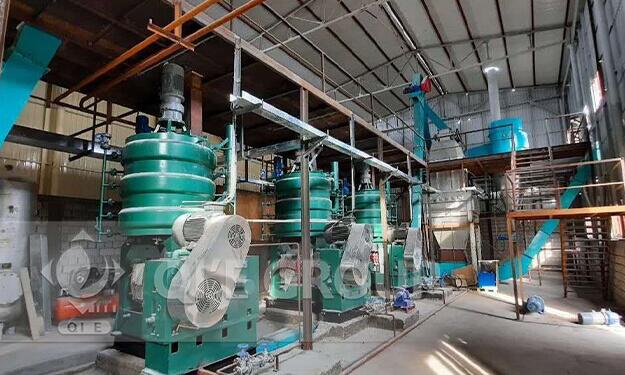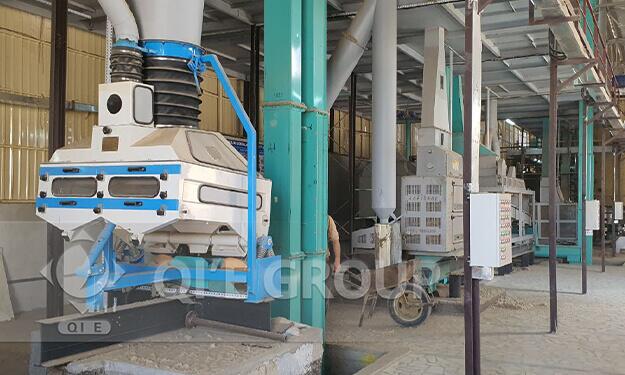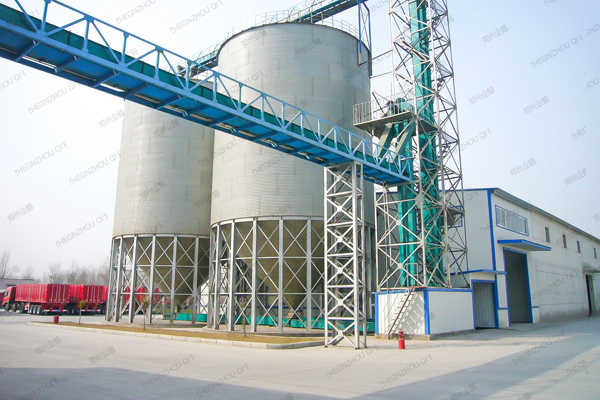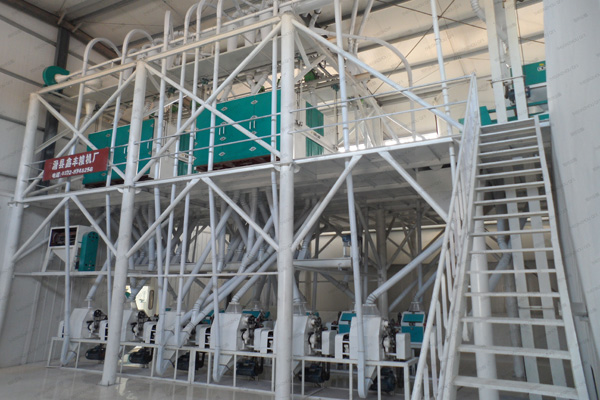The edible oil production line can process 150 tons sunflower seeds every day. The main production processes included raw material storage, screening, stone removal, crushing, softening, flaking, steaming, oil pressing and filtering etc.
According to the special requirements of the customer, our company designed this sunflower seed oil pressing production line. The project is divided into three phases. The first phase is expected to produce 150 tons of sunflower seed pressing per year, the second phase is expected to produce 150 tons of sunflower seed oil per year, and the third phase is expected to refining and dewaxing.


1.Raw material receiving and storage
Raw sunflower seeds are received and stored in storage silos for continuous production.
2.Screening
Screening is based on the difference in size between oil seeds and impurity particles, as well as the relative movement of the oil seeds and the screen surface, to remove impurities larger or smaller than the oil seeds through the sieve holes. Commonly used screening equipment in oil plants include vibrating screens, flat rotary screens, rotary screens, etc. Most screening equipment has an important working part, which is the screen. The size and shape of the sieve holes should be determined based on the actual size of the oil particles.
3.Stone Removal
This method is based on the differences in the specific gravity and suspension speed of oil seeds and stones, and uses the combined action of an inclined screen surface with certain movement characteristics and the air flow passing through the screen surface to achieve the purpose of graded stone removal. Suction gravity destoners are commonly used in grease processing plants. Its characteristic is that the internal pressure of the stone removal machine is negative when it is working, which can effectively prevent dust from flying out. The output of a single machine is large, but it needs to be equipped with an independent suction and dust removal system. The blast type specific gravity destoner is equipped with a fan and has a simple structure, but its working conditions are poor and its output is low, so it is only used in small grease processing plants.
4.Crushing
Before sunflower seeds can be flaked, large sunflower seeds must be crushed. The purpose is to make sunflower seeds have a certain particle size through crushing to meet the tableting conditions. The surface area of crushed sunflower seeds increases, which is beneficial to the transfer of temperature and moisture during softening and improves the softening effect. It is required that the crushed sunflower seeds have uniform particle size, no oil, no agglomeration, less powder, and the particle size meets the requirements. The particle size of the crushed sunflower seeds is 4-6, and the powder degree of the crushed sunflower seeds is controlled to be less than 10% through a 20 mesh/inch sieve. The maximum diagonal length of the pre-pressed cake after crushing is 6-10 mm. In order to meet the crushing requirements, the moisture content of the oil needs to be controlled during the crushing process. If the moisture content is too high, the oil will not be easily crushed and will easily be flattened and produce oil. It will also cause problems such as difficulty in discharging materials from the crushing equipment and reduced output. If the water content is too low, the degree of crushed oil powder will increase, and the oily powder will easily stick together to form clumps. In addition, the temperature of the oil will also affect the crushing effect. The powder after crushing hot oil seeds is smaller, while the powder after crushing cold oil seeds is larger. Generally, the suitable moisture content for sunflower seed pressing is 10% to 15%. Grease crushing methods include impact, shear, extrusion and grinding. Commonly used crushing equipment includes tooth roller crushers, hammer crushers, disc shellers, etc. Here, a toothed roller crusher is used to crush sunflower seeds.
5.Softening
Softening is to improve the elasticity and plasticity of the oil by adjusting the moisture and temperature of the oil, so that it has the best conditions for rolling, reducing the powderiness and adhesion during tableting, and ensuring the quality of the tableting. Softening is mainly used for grease with low oil content, low water content and high shell content, which has poor plasticity and hard texture. Sunflower seeds have low oil content and poor plasticity, and should be softened before tableting. The rolling temperature should be determined according to the moisture content of the sunflower seeds. When the moisture content of sunflower seeds is 13%-15%, the softening temperature is usually controlled at 70-80 degrees, and the softening time is 15-30 minutes. Commonly used softening equipment includes layer softening pot and drum softening pot. Here we choose a drum-type softening pot with better softening effect.
6.Flaking
Flaking is a process that uses mechanical force to squeeze oil from granular form into flakes. The purpose of pressing is to destroy the cell structure of the oil, increase the surface area of the oil, shorten the distance of oil outflow, and facilitate oil extraction and evaporation. Tablet pressing is the key to pretreatment, which is related to the quality and oil yield of grease. The key to tablet compression lies in the operation of the tablet press. In order to ensure tableting quality, the moisture and temperature of the material should be strictly controlled before tableting. It is best to install a softening box on the tablet press to avoid excessive loss of moisture and temperature after softening. Before starting, the working condition of the tablet press should be carefully checked. If the thickness of the pieces at both ends is uneven or there is un-rolled oil mixed in the pieces, stop checking and adjust the rolling distance (the two sides should be balanced, and do not adjust too tightly). Check whether the scraper is close to the roller surface to prevent roller sticking. Pay attention to flow uniformity and prevent no-load operation. Generally speaking, the finer the oil is rolled and the more the cell structure is destroyed, the better the oil extraction effect will be. The requirements for the tablet press are that the tablets are thin and uniform, the powder is small, and there is no oil leakage. Whether it is pressing or leaching, the thickness of the oil flakes has a great impact on the oil yield.
7.Steam Cooking
The purpose of this step is to increase the inlet temperature of the oil pieces so that they bring out more oil.
8.Oil Pressing
The oil flakes are then fed into the screw oil press machine. Screw oil presses use the friction and continuous pressure of the screw drive to move and compress the oil flakes. The oil flakes pass through the small opening, which does not allow the seed fiber solids to pass through. Then, the pressed oil flakes form a hardened cake and are removed from the machine. The pressure during the pressing process generates heat in the range of 140–210 °F (60–99 °C). The raw material is typically heated to 250 °F (121 °C) to make the press more efficient, otherwise the press itself heats the oil to 185–200 °F (85–93 °C).
9.Oil Filtering
Oil filtration can filter the raw pressed oil and remove impurities in the oil, which makes the later refining process easier.




